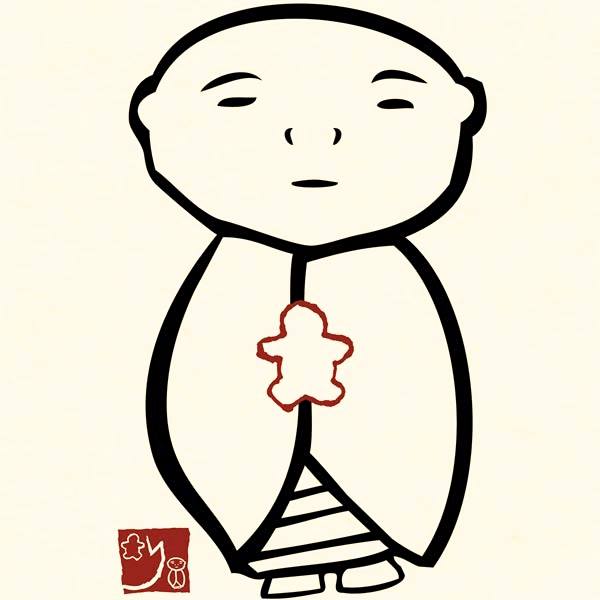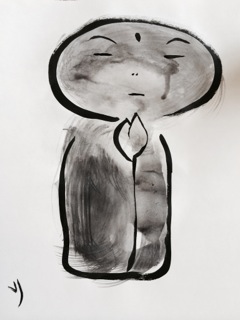
In the ongoing quest to mend our anxious minds, many of us are drawn to meditation.
Once we begin, we find that we fidget, we get sleepy, we get bored. We don’t do it right, we fail, we quit, we start again only to quit again.
Our expectations of finding peace are not met and we think we have failed. We want to be grounded, we want to detach, but we can’t—or if we do, it only lasts until the next car cuts us off on the freeway, someone disappoints us or we have a craving for chocolate.
Accepting that the ground within us is always in motion, like weather patterns, is difficult. After all, our psyche is invisible to us.
Jizo has helped me greatly in this kind of work. He is the Buddhist archetype for Mother Earth. In Sanskrit, his name is Ksitigarbha, which means Earth Womb. Jizo vowed to Buddha to stay on earth until everyone has finished suffering and to protect all living beings on their journeys.
We seek to be grounded, but cannot find the solid ground.
Imagine, for the sake of this exercise, that Jizo is your metaphorical ground. Awakening your Jizo-nature is a lifelong process rather than a cataclysmic event that alters us forever.
It’s not a quick fix. It’s not a promise that you won’t be anxious or depressed any more (borne out of a few successful meditation sessions).
All it means it that you will be more awake, with an awakened heart, a compassionate heart, toward the busy-ness that is your mind.
In my work with Jizo Therapy, I have been exploring the use of tapping.
Tapping, aka EFT, is all over the web, in dozens of YouTube videos, pain clinics, international conferences full of audiences ranging from Princeton academics to self-appointed life coaches. If you have tried meditation and quit, if you have tried tapping and quit, try this little exercise with me and see if you notice a shift, even a small one.
Find a quiet place where you may not be disturbed for 15 or 20 minutes. As you sit in meditation, follow the chart of the tapping points below.

Envision the various acupressure points in your body that are delineated on the chart. The Karate Chop side of your hand is the starting place. Then, the top of your head, the top inside of an eyebrow, the outer edge of your eye, under your eye, right below your nose, under your lower lip, at your collar bone, under your arm. That’s the tapping circuit.
Left or right, your choice. Just experiment, be curious. Try.
Tap each area while taking two natural breaths. Don’t force the breath, don’t take deep inhalations, just begin by letting the body do its own breathing, without interference. If this is difficult, then that’s the first subject to tap on. That’s your first thought,
“I am not breathing right.”
So, beginning with the karate chop part of your hand, tap while speaking aloud,
“I can’t even breathe right when I start to meditate.”
Or, say whatever it is that arises for you, in your own words. (As you read my suggested words, your own words may come to mind. Trust them, try them out. Use mine only as a guideline.)
Tapping the top of your head, say, “I get so frustrated that the moment I try to breathe naturally, I get anxious and controlling and can’t even let my breath flow in and out of my body.”
Eyebrow tapping: “I hate meditation. It’s stupid.”
Side of the eye: “What does anybody get out of sitting in meditation, anyway?”
Under the eye: “I have absolutely no patience.”
Under the nose: “I am patient with others but not with myself. Everyone gets a break but me.”
Under lower lip: “I can’t believe that tapping on my body and breathing is going to bring me any kind of peace.”
Tapping the collar bone: “This is total bullshit and I am really uncomfortable.”
Still tapping, now under the arm: “I wish I could find some peace, just for a little while.”
I suggest running your eyes back up this page and doing this cycle three times, pausing for a few moments after each complete cycle, after tapping under your arm and saying, “This is crap and I am really uncomfortable.”
As you pause, notice if there is any difference in your breathing since the first round, the second round.

Then, allow a gentle half-smile on your face, letting your body breath naturally and tap the top of your head.
Say “Even though I will probably never get the breathing right, I love and approve of myself.”
At this moment, you might feel a need to change windows on your computer, get up and walk away or check your email. That is to be expected, because anxiety is really uncomfortable. Any venture into the unknown can make us anxious, make us want to avoid, want to eat, drink, drug, hide, pretend, binge on TV, eat some more.
But if you can, stay with me on this. Stay on the cushion, just sit. Tap and sit. Tap and sit.
We resume, tapping above the eyebrow: “Even though I want to run from these feelings, I am willing to accept myself right now, just as I am.”
Outside of the eye: “Even though I think this is useless bullshit, right now in this moment, I love and accept myself, just as I am, a fidgety ball of tension.”
Tapping under the eye: “Even though I will never get this right and will always be moody, I accept myself right here, right now, in the most friendly way.”
Tapping under the nose: “I may have tension throughout my body, but I won’t hate it, instead I will accept it just for this moment, as it is.”
Tapping under the lower lip: “Even though this is a useless exercise in pseudo-spirituality and I will never have a moment of real enlightenment, I love me just now, just as I am.”
Tapping your collarbone: “Even though I feel like the biggest loser as a meditator, there’s a bodhisattva named Jizo who holds all living things safely, and I am going to open to the idea that this can be awakened inside me.”
Tapping under the arm: “Jizo, please hold the anxious and sad parts of my mind safely, please put some ground under me so that I can find my center.”
Take a pause. Notice how you feel. Then, begin again.
Back up to the top of the head: “Jizo promised to stay on earth until everyone was finished suffering.”
Above the eyebrow: “I can awaken the bodhisattva within me, even if I don’t believe in it, I can try.”
Tapping, tapping, through each of the points, repeating: “I can awaken; I can awaken the bodhisattva within me, the Jizo within me.”
Pause. Notice how your body feels, notice your breath.
Tap both Karate Chop points, left and right hand together and smile as you exhale and whisper, “Thank you.”
Pause again and notice the sounds around you. Notice your inner world.
This is a practice. It’s something you do every day whether you feel like it or not.
I suggest tapping before breakfast, lunch, dinner and bedtime on a consistent basis, whether you feel like you need it or not.
I combine it with yoga, tapping in savasana—corpse pose—as I feel even more focused if I take a few moments to let my body and mind settle, then tap, then rise up and go into the next few asanas and then lie down, tap to the next stage of what is arising and then settle again.
Then, notice that your body knows how to breathe without asserting any control on your part, and smile on the exhalation.
And rest.
Love elephant and want to go steady?
Sign up for our (curated) daily and weekly newsletters!
Apprentice Editor: Brandie Smith/Editor: Catherine Monkman
Photos: Author’s Own.










Read 0 comments and reply